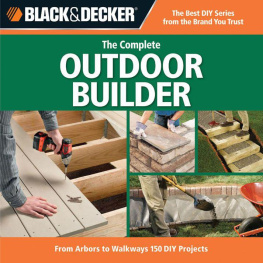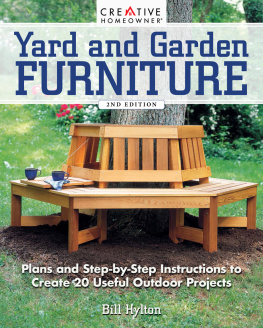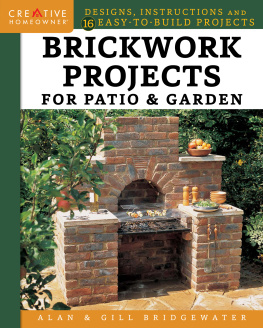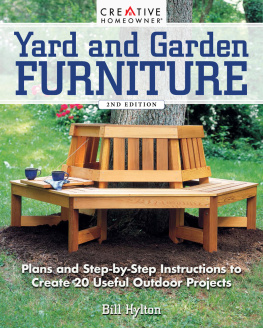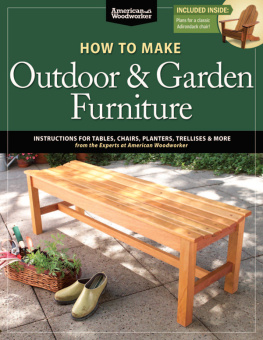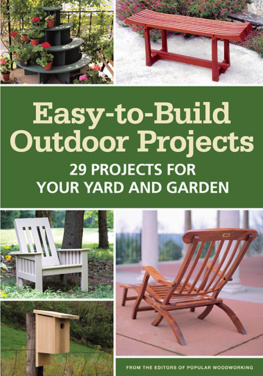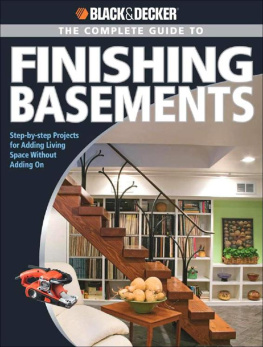THE COMPLETE
OUTDOOR
BUILDER

The Complete
OUTDOOR
BUILDER
From Arbors to Walkways 150 DIY Projects

Contents
Introduction
Many homeowners and do-it-yourselfers narrow their focus to the interior of their homes as they dream and plan for upcoming projects. However, the area outside of your home is a perfect place to exercise your creativity and is overflowing with possibilities. Whether your front steps simply need a makeover or you think a new greenhouse or shed would give you the extra space you need to fully explore your hobbies, The Complete Outdoor Builder has the ideas and know-how to help you turn your plans into realities.
Whether youre new to outdoor home improvement or a seasoned veteran, start with the Planning section, which covers essential information about seeking permits, how to estimate and order materials for outdoor construction, and the tools, codes, and challenges of outdoor building. This section also includes insight on how to draw plans to help you ensure that your project ends up as exquisite in real life as it is when you imagine it.
The next sections each cover a different area of outdoor construction, from Pathways & Patios to Porches and Sheds & Outbuildings. Projects as simple as building walkways, sidewalks, and patios or as complex as constructing a childrens play area from lumber and basic tools are all included in these sections. Pay careful attention to the first few pages of each, which will cover basic techniques to help you complete your project with ease.
After that, be grand in your ambitions and tackle projects both familiar and challenging. If your needs are practical, perhaps you should review how to pour a concrete patio, install a panel fence, or build a childrens timberframe sandbox. If youre ready for a larger project, why not build that deck youve been wanting to sit on, screen your porch, or build a service shed for firewood or yard implements. Perhaps, however, you feel like your yard needs dressing upperfect! Use our plans to construct a garden pond and fountain, a backyard putting green, or a beautiful brick archway over your front drive. The projects in this book include lists of the tools and materials youll need, the lumber youll need to purchase, and in some cases, the entire plans for a large-scale projects.
Whatever your ambitions, The Complete Outdoor Builder has the tools, expertise, ideas, and simple how-to instructions with large, easy-to-understand photographs to guide you from start to finish. Even if youre a beginner, youll find many projects here that are well within your abilities. And remember, with each new project you tackle, youll acquire new skills and gain the confidence to take on larger ones. So what are you waiting for? Start making your backyard dreams a reality today.

Planning

Homeowners no longer think of their yards as great expanses of lawn, but as outdoor living spaces. Permanent outdoor structures can add to the beauty and function of these outdoor rooms. For example, a deck can provide additional space for entertaining or relaxing, a wall can provide privacy and texture, and a walkway or path can unify areas.
But before you can begin building, you have to organize your ideas and create a plan for materials, tools, inspections, measuring, and construction. Proper planning will help you create an outdoor project that is beautiful now and will last for years to comean important consideration, since landscaping contributes about 30 percent to your homes total value.
This opening section will provide you with all the information you need in order to plan and design the projects of your choice. Well look at new and standard materials for outdoor projectsincluding wood, metal, plastic, manufactured and natural stone, and concreteand show you how to estimate and order supplies. You will find information on basic and specialty tools and a discussion of the common types of hardware and fasteners used for outdoor projects. Well also review the basics of building codes, including permits and inspections. And to ensure you get the results you want, well show you the techniques youll need to design your own projects.
By following these planning strategies, you will save time and money and enjoy your outdoor home for years to come.
Building Materials
The building materials you choose should reflect both the function and the appearance of your outdoor project. Materials impact not only the style, but the durability, maintenance requirements, and overall cost of a project. Wood, stone, and brick are traditional favorites, but the versatility and ease of installation you get with PVC vinyl, metal, and concrete make them attractive options for certain applications.

Wood is the most common, and arguably the most versatile, of building materials. Carefully choose lumber that is appropriate for your project.
Lumber
Wood remains the most common building material in outdoor construction, and it is usually less expensive than stone or brick. Its versatility lends itself to just about any project, from the plain and practical to the elegant and ornate. It is ideal for decks and walkways, fences and retaining walls, pergolas and screens, outdoor furniture, and of course, outbuildings. And it is beautiful, blending with most architectural styles. It looks especially attractive in settings surrounded by trees.
Most home centers and lumberyards carry a wide selection of dimension lumber, as well as convenient preassembled fence panels, posts, pickets, rails, balusters, floorboards, stringers, and stair railings. Inspect all lumber for flaws, sighting along each board to check for warping, twisting, or loose knots. Boards used for structural parts should have only small knots that are tight and ingrown. Inspect the end grain also. Lumber with a vertical grain will cup less as it ages. Return any boards with serious flaws.
Framing lumbertypically pine or pressure-treated pinecomes in a few different grades: Select Structural (SEL STR), Construction (CONST) or Standard (STAND), and Utility (UTIL). For most applications, Construction Grade No. 2 offers the best balance between quality and price. Utility grade is a lower-cost lumber suitable for blocking and similar uses but should not be used for structural members. Board lumber, or finish lumber, is graded by quality and appearance, with the main criteria being the number and size of knots present. Clear pine, for example, has no knots.
The most important consideration in choosing lumber is its suitability for outdoor use. Select a wood that is not prone to rot or insect attack. Three types are generally recommended: heart cedar, heart redwood, and pressure-treated lumber. Redwood and cedar are attractive, relatively soft woods with a natural resistance to moisture and insectsideal qualities for outdoor applications. Heart or heartwood varieties will be identified on the grade stamp. In both redwood and cedar, heartwood has better resistance to decay than lighter-colored sapwoods. Western red cedar (WRC) or incense cedar (INC) for decks should be heartwood (HEART) with a maximum moisture content of 15 percent (MC15).
Next page
